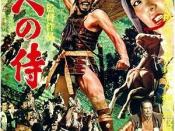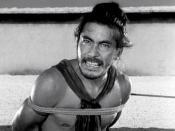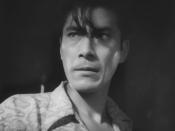Akira Kurosawa's Roshomon has been hailed as, "arguably the classic, enduring, and most influential of all courtroom feature films."� The film presents one afternoon's events as told by four different parties. Objectively, the film presents the theory that empirical truth does not exist and that therefore, legal truth is only a rationalization by a judge or jury of independent perceptions of truth. However, the film does more than question the existence of truth, legal or otherwise. Roshomon presents its own version of truth, a version in which women are depicted as inherently weak, deceitful and evil.
The film depicts the woman as victim, seductress, accomplice (to murder) or murderer in all four versions of the events of that afternoon. However, the viewer need only analyze Tajomaru's version of the facts to know that the writer/director, in a veiled but tactful manner, meant to shed a negative light on the character of the woman.
The story unfolds with a common man rushing for shelter from the rain. Here in the remains of the Roshomon gate he encounters a priest and a woodcutter discussing the horrifying events of the afternoon. The men state that "[they] don't understand it; [they] don't understand it at all."� They go on to pronounce that nothing could be as terrible as this""worse than fires, wars, epidemics and famine. The horror they describe pertains to the murder of a samurai and the events surrounding his death. Although the viewer later finds out that along with the question of murder, there is also a question of rape; the characters in the opening scene make no mention of that crime. This inherently suggests that a woman's rape is not even worthy of a passing thought where there is the much greater issue of a man's death.
Tajomaru, the bandit, tells the first full version of the events, and is the only character that describes sexual act/rape. It is not incidental that the bandit tells his story first and that he is the only character that describes the full detail of the rape/sex act. The viewer gets their first exposure to the crimes through the bandit's eyes, and his story creates a picture of the woman as an object of desire who succumbs to his advances and solicits the murder of her husband. Tajomaru blames the events of that afternoon on a gust of wind and the woman's incredible beauty. His account lays all blame on nature and women for the wrongs of man. The writer/director clearly states an opinion here about the power women have over men, but how women only use that power to deceive and harm. The writer/director depicts the bandit as a wild/crazed man, which might negate some of his veracity as a witness. However, the writer/director givers only a cursory gloss of Tajomaru's villainous character, but delves deeply into the immorality of the woman. Therefore, by placing the bandit's story as the first major scene and making statements that clearly stand in judgment of women and their ills, the audience is presented with the writer/director's negative implications about women.
Tajomaru describes a complicit sexual act in his version, by no means a rape. He does admit that the woman reacted violently at first, but this only increases his desire for her. However, when he kisses her, she returns his passionate embrace. Hence, no rape occurs in his version of the events. This is an important fact that might go unnoticed by the audience, but was not coincidental on the part of the writer/director. The lack of a rape in the bandit's story creates a layer of doubt in the viewer's mind as to whether a rape did occur. Although his actions and demeanor seem like those of a crazy man, his position as first storyteller lends itself to becoming the backdrop by which the other stories are judged. It puts the viewer on notice that a rape may or may not have occurred, and this puts the woman's version of the facts under scrutiny before she has even spoken.
Psychologically the placement of the bandit's tale first also affects the viewer because humans are prone to remembering the first and last thing they hear in a series. Even if the viewer decides to discount Tajomaru's story because of his reputation, they are doing so by comparison to the other versions. If the bandit's story had been later in the sequence of stories, the audience might have discounted his tale merely by virtue of his being a disreputable character.
It is important to note that the audience does not only hear the bandit's recollection of the events, they see the story unfold before their eyes. The scene depicts his version of the facts, but the director chose to act the story out instead of merely letting the audience hear the bandit speak. This creates a mental/visual picture for the audience of the woman's depravity. The audience watches as she quickly turns her anger to lust and melts in the arms of her would-be attacker. The camera stops for a full moment on her face as it changes from denial to acceptance. The writer/director makes a clear statement about the woman's weakness when she succumbs to the bandit, and it is purposefully visually depicted in order to impress the woman's shortcomings upon the audience early on in the film.
Tajomaru's version of the story not only shows the woman's weakness and sexual depravity, it also portrays her as a less than a person. She is merely the possession of whichever man owns her. The writer/director obviously wrote the piece about 12th century Japan where women were considered second-class citizens; nonetheless, the woman is not just depicted as a second class citizen in Tajomaru's story, she is depicted as the worst kind of woman, a woman without honor. The writer/director could have changed the story, and its portrayal of women drastically, by having the woman take her own life. In 12th century Japan her suicide would not only seem appropriate, but honorable in the eyes of the community, the gods, and even the 1950's audience viewing the film. However, the film purposefully ignores this "honorable"� option and continues to denigrate the woman's character.
Even though the film portrays the woman as weak and a second-class citizen, it could easily depict her an innocent victim of the circumstances, but it does not. The film depicts the woman as deceitful and evil. The film suggests that she did not just succumb to the bandit's seduction, but that her beauty seduced the bandit. As if she had power over the bandits decision to tie up her husband and then take her. In addition, the film depicts the woman's evil character when she asks the bandit to kill her husband. The request might be shrouded as a protection of her honor, but the way she looks at her husband, with loathing and disgust, tells the audience that she means to do him harm. Again the writer/director chose to create an image of a deceitful and wicked woman who would rather see her own husband die than live with the memory of her indiscretions.
The film goes on to show the duel between the bandit and the samurai. The woman has promised herself to Tajomaru if he will kill her husband and erase the memory of his hatred. The two men battle and the bandit kills the samurai, but the woman does not stay to live out her promise. The viewer sees her running from the scene of the duel. The audience can come to two conclusions, either she never wanted to be with the bandit, and she had sex with him out of wanton lust; or she never meant to keep her promise to the bandit and deceived him in order to have her husband killed. Either way the film has effectively turned the woman into a sexually weak woman, a liar, and an accomplice to murder.
Roshomon has been hailed as one of the most influential legal movies ever produced. Unfortunately, the movie portrays women as sexually weak deceitful creatures who will use their sexuality to get what they want, even if that includes murder. The movie does this by creating a pattern of action on the part of the one female character, which repeatedly shows her wanton, deceitful and eventually murderous ways. The writer/director specifically makes these points in Tajomaru's story. At no point in the bandit's story does the woman seem like the victim of a violent sexual act, or a pawn in a male dominated society. The film exemplifies a subtle yet unwavering contempt for women, which demonizes the woman character and strips her of any redeeming qualities.






